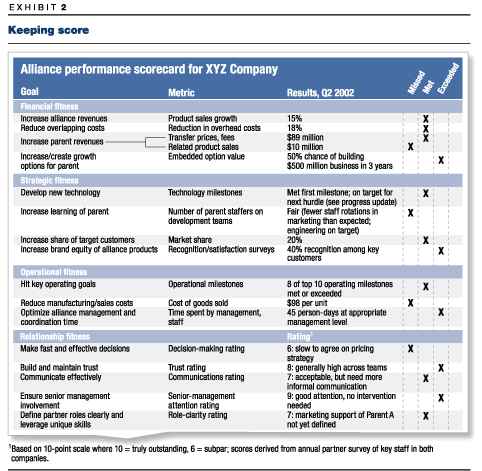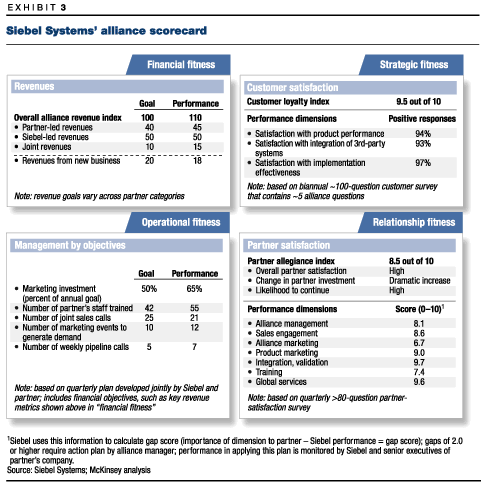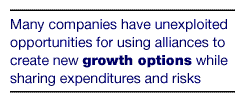

Large companies often have dozens of alliances—and little idea how they are performing.
James Bamford and David Ernst
|
Large companies often have dozens of alliances—and little idea how they are performing. |
James Bamford and David Ernst |
|
As corporations have evolved from command-and-control structures with sharply defined boundaries into loosely knit organizations, corporate alliances have become central to many business models. Most large companies now have at least 30 alliances, and many have more than 100.
Yet despite the ubiquity of alliances—and the considerable assets and revenues they often involve—very few companies systematically track their performance. Doing so is not a straightforward task. In our work with more than 500 companies around the world, we have found that three problems typically bedevil efforts at measurement. The first is a failure to measure the performance of individual alliances rigorously. Our experience suggests that fewer than one in four of them has adequate performance metrics. As a result, alliances are run by intuition and incomplete information; partners may not agree about the progress of their ventures; and senior management can’t intervene quickly enough to correct problems. Companies frequently have three to five major alliances in desperate need of restructuring—but don’t know which ones they are.
Second, companies often fail to recognize performance patterns across their alliance portfolios—patterns concerning particular deal structures, types of partners, or functional tasks. A failure to spot and fix such recurring problems can be costly; one leading pharmaceutical company had so many slow launches, for example, that it was losing an estimated $500 million a year from missed product sales and other opportunities.
Finally, few senior management teams know whether the alliance portfolio as a whole really supports corporate strategy. Executives at a leading US airline, for instance, couldn’t quantify the total revenue from its alliances five years after it made them a centerpiece of its international strategy and thus had no idea if the returns were positive or negative. (They have since calculated that the deals generate $500 million a year in direct revenue, plus indirect revenues and cost savings.)
At a time when alliances are increasingly important, underinvesting in efforts to measure their performance isn’t a realistic choice. To get the maximum value out of all alliances and the ability to intervene when their performance veers off track, managers should learn to measure their fitness on several levels—a process that can also reveal fundamental weaknesses in the way companies create and manage them. With this deeper understanding, senior executives can assess whether alliances fully contribute to the corporate strategy and can spot new opportunities to use them.
The challenge
To measure the performance of alliances accurately, a company must start by recognizing the obstacles. Because each partner has its own reporting processes and systems, the first hurdle is agreeing on a common approach to performance measurement. Each partner might have different aims (such as gaining access to specific technologies or customers), so it can be hard to agree about what to measure. And since alliances are fundamentally about collaboration, managers must constantly attend to the health of the relationship—a "soft" and frequently overlooked issue.
Second, the operations of an alliance are often entwined with those of the parent companies, and this complexity makes benefits and costs difficult to track. Most alliances receive some inputs—raw materials, customer data, administrative services—from the parent companies and provide outputs to them, thereby creating complicated transfer-pricing issues. Before Airbus Industrie was revamped in 2001, for instance, the four consortium members made aircraft sections and "sold" them to the joint venture, which then assembled and marketed the airplanes. Setting accurate transfer prices was a challenge because of the sensitivity of the partners about sharing detailed cost data.
 Then there is the problem of measuring costs. In many cases, early estimates
are exceeded because the partners fail to consider the expenses of coordinating their
activities or the value of senior management’s time. For example, a contractual
alliance that two global technology companies forged for the purpose of jointly marketing
a new product involved more than 30 working teams, most of whose 300-odd members spent no
more than 60 percent of their time on the alliance and some as little as 20 percent. One
executive admitted that he had no real idea how much the company had spent on the venture,
so large were its concealed expenses.
Then there is the problem of measuring costs. In many cases, early estimates
are exceeded because the partners fail to consider the expenses of coordinating their
activities or the value of senior management’s time. For example, a contractual
alliance that two global technology companies forged for the purpose of jointly marketing
a new product involved more than 30 working teams, most of whose 300-odd members spent no
more than 60 percent of their time on the alliance and some as little as 20 percent. One
executive admitted that he had no real idea how much the company had spent on the venture,
so large were its concealed expenses.
Measuring benefits is a challenge as well, because of interdependencies between alliances and their parents. An alliance often generates sales of related products for the parent companies, to give one example, and these too should be taken into account in assessing its performance and value. So should intangible benefits, such as opportunities for learning, access to new technologies and markets, and improved competitive positioning.
A further problem is the peripheral position of alliances, which often fall between business units and are neither fully owned by nor fully outside of the corporation. As a result, alliances can receive less management scrutiny than internal initiatives. Unless a corporate executive accepts responsibility for overseeing all or most of a company’s alliances, no one will take the time to identify broader performance patterns or to assess the company’s alliance strategy.
Measuring performance
To meet these challenges, companies must assess the performance of their alliances on three levels, each focusing on different aspects of the problem and prompting distinct managerial responses.
At the first level, every alliance should be assessed to establish how it is performing and whether the parents need to intervene. The assessment creates the foundation for the next level, which is to search periodically for performance patterns across the portfolio—a process that often leads to adjustments in the types of deals a company pursues and sometimes to additional investments in building alliance-related skills. Once a company better understands how its portfolio is performing, it can conduct a top-down review of overall strategy in order to ensure not only that its alliance portfolio is configured in the best possible way and contributes sufficiently to its performance but also that it has ranked new opportunities in a clear order of priority.
Individual alliances
Developing, up front, a detailed view of the economics of an alliance is indispensable to measuring its performance. The process should go beyond the usual cash flow metrics to include transfer-pricing benefits, benefits outside the scope of the deal (for instance, sales of related products), the value of options created by the alliance, and start-up and ongoing management costs (Exhibit 1). This information helps managers to evaluate deals up front and to monitor their continuing performance.

Once a company has a clear view of the economics, the next step is to develop, within 30 days of the launch, a scorecard to track the venture’s performance. Partners must decide whether to share a single alliance scorecard, to have separate scorecards, or to develop some combination of the two. For a joint venture with its own P&L, a single scorecard is often possible; for most other alliances, the combination approach works best. Each partner can supplement a shared scorecard with additional metrics tracking the progress of an alliance against goals (such as learning or strategic positioning) that aren’t shared by the other partners. This approach also enables each partner to devise internal metrics that allow it to compare the performance of an alliance with the performance of wholly controlled activities and of other, similar alliances (Exhibit 2).

It is essential, at both the alliance and the parent level, to take a balanced view of performance. To achieve such a balance, we have found it useful to include four dimensions of performance fitness: financial, strategic, operational, and relationship. Financial and strategic metrics show how the alli-ance is performing and whether it is meeting its goals—but may not provide enough insight into exactly what, if anything, isn’t going well. Operational and relationship metrics can help reveal the causes of problems and uncover the first signs of trouble. Together, the four dimensions of performance create an integrated picture that has proved invaluable to the relatively few companies, such as Siebel Systems, that have used them to measure the health of alliances (Exhibit 3).

Financial fitness: Metrics such as sales
revenues, cash flow, net income, return on investment, and the expected net present value
of an alliance measure its financial fitness. Most alliances should also monitor progress
in meeting their most important financial goals: reducing overlapping costs, achieving
purchasing discounts, or increasing revenues. In addi-tion, financial fitness can include
partner-specific metrics such as transfer-pricing revenues and sales of related products
by the parent companies.
Many alliances are formed to generate future options rather than imme-diate returns. In
this case, executives should track a deal’s option value, which can change as a
result of technical progress or external market conditions, and monitor cash outlays
against expected returns.
Strategic fitness: Nonfinancial metrics such as market share, new-product launches, and customer loyalty can help executives measure the strategic fitness of a deal; other metrics could, for example, track the competitive positioning and access to new customers or technologies resulting from it. Devising strategic metrics can take imagination. The international semiconductor research consortium SEMATECH, for instance, tracks the number of employees from member companies who are working on its research initiatives in order to assess whether it is transferring knowledge to its partners.
Operational fitness: The number of customers visited and staff members recruited, the quality of products, and manufacturing throughput are examples of operational-fitness metrics, which call for explicit goals linked to the performance reviews and compensation of individuals. Executives at one health care company define operationally fit alliances as those hitting 60 to 80 percent of their key operating milestones; any figure higher than 80 percent indicates that the goals weren’t sufficiently ambitious.
Relationship fitness: Questions such as the cultural fit and trust between partners, the speed and clarity of their decision making, the effectiveness of their interventions when problems arise, and the adequacy with which they define and deliver their contributions all fall under the heading of relationship fitness. To measure it, Siebel Systems developed a sophisticated partner-satisfaction survey, sent each quarter to key managers of alliance partners, that contains more than 80 questions about issues such as alliance management and partners’ loyalty to Siebel. The company uses this information to spot problems and to develop detailed action plans to address them.
The weight placed on each type of metric and the amount of detail included in it depend on the size and aims of the alliance. A consolidation joint venture whose main goal is to reduce costs, for instance, should focus heavily on financial and operational metrics. But managers of an alliance entering a new market expect negative financial returns in the early going, so more weight should be given to strategic goals such as increasing market share and penetrating distribution channels. Smaller, short-term alliances might have simple scorecards with only four or five metrics; larger ventures with substantial assets or revenues deserve something more detailed.
Scorecard results provide important clues to what might be going wrong with an alliance, but uncovering the true problem often requires further investigation. Close scrutiny of the alliances of a large media company that had invested hundreds of millions of dollars in them, for example, revealed that five of its ten most important deals were hemorrhaging money. Further probing revealed three unprofitable arrangements that could be renegotiated, thereby saving $23 million a year. In addition, two joint ventures with an international media company were troubled by flawed deal structures from the start; redefining each partner’s contributions and responsibilities enabled the company to save an additional $45 million a year. This powerful experience led it to establish a corporate-level alliance unit to keep a critical eye on all of its ventures.
Assessing portfolio patterns
Identifying the problems of individual alliances will probably expose problems in the portfolio as a whole, perhaps indicating deeper weaknesses in the company’s method of choosing and managing alliances. In looking for such performance patterns, corporate managers should consider a number of questions.
Which types of alliances perform well for the company? Do research alliances, for example, succeed better than marketing alliances, or do joint ventures work better than contractual alliances? Failure may be a result of a poor fit with the company’s needs or of bad execution. This information might push the company to select, structure, and value deals differently in the future.
Does the company consistently stumble at a particular stage, such as structuring and launching a deal or managing the alliance after the deal has been done? Trouble in any of these areas will show up in the scorecard: alliances that get off to a slow start, say, will miss their earliest operational milestones, while those with ill-defined governance structures will be hampered by slow decision making. Alliances that have the wrong deal structure or don’t get enough management time or resources will probably miss targets across all four dimensions of performance.
Are alliances with specific partners or types of partners more successful than others? Like the failure of certain types of alliances, these patterns could reflect a troubled relationship with just a single partner—a relationship that might be fixed or abandoned—or could suggest, more broadly, that certain types of partners (for instance, smaller ones) require a different approach.
Even companies that have the most experience with alliances often endure recurring problems. One leading US health care concern had invested almost $2.5 billion in alliances but never systematically examined the performance of its entire portfolio. When it did so, it quickly found several consistent problems. First, deals had been struck with loose operating plans, forcing the alliance managers to spend a year or more developing detailed arrangements without the benefit of close input from corporate management. Second, the partners’ contributions and decision-making processes were often poorly defined. Finally, many of the alliances lacked explicit operational milestones, so that the partners later found it hard to assess whether ventures were on track. The health care company subsequently produced detailed business plan templates and changed its alliance organization and processes in order to ease the passage of future deals.
A company that has repeated problems with its alliances can find that its reputation (or "alliance brand") is damaged and that it can no longer attract the best partners or maintain their trust—particularly in industries, such as pharmaceuticals, in which companies depend on exclusive or semiexclusive alliances and must compete for them against companies with similar capabilities. For example, one survey ranked Pfizer and Merck as the partners of choice in the pharmaceutical industry. Meanwhile, a certain competitor, with an undifferentiated alliance brand (and a lower ranking), received fewer unsolicited proposals from the biotechnology start-ups that are the source of many new drugs, closed fewer deals, and was considered less trustworthy by partners.
Corporate strategy and the alliance portfolio
 Too often, an alliance portfolio grows into a random mix of ventures
assembled over the years by various business units. Even if a deal made sense when first
negotiated, the portfolio is unlikely to be as good as it could be in view of the current
strategy of the company or even of a business unit. One European industrial-gas company,
for instance, found that 40 percent of its alliances no longer reflected its current
strategic priorities but still received a large amount of senior management’s time.
Too often, an alliance portfolio grows into a random mix of ventures
assembled over the years by various business units. Even if a deal made sense when first
negotiated, the portfolio is unlikely to be as good as it could be in view of the current
strategy of the company or even of a business unit. One European industrial-gas company,
for instance, found that 40 percent of its alliances no longer reflected its current
strategic priorities but still received a large amount of senior management’s time.
To avoid (or fix) this problem, the senior executives of a company must periodically reassess the contribution of alliances to its corporate and business unit strategies. How is the overall portfolio performing? Is the company exploiting its most valuable opportunities? Does it have clear priorities for developing future alliances? Like an annual review of capital spending, this process should ensure that the company has a coherent portfolio and is allocating resources among current ventures and potential new deals to maximum effect.
The first consideration is the performance of the portfolio as a whole. With a coherent alliance strategy and an appropriate linking of partners, a port-folio can be more than the sum of its parts. One electronics device company, for example, fosters relationships among its software-development partners by inviting them to an annual meeting, which helps it to improve its product offering and to speed up the introduction of add-on items. Another electronics company found that several operating units had alliances with the same partner but failed to coordinate their efforts. The mixed messages sent by different business units to the partner’s management led to friction, and the company has since appointed alliance directors to oversee individual partner relationships. Senior executives should also use metrics such as value creation or contributions to annual profits to review the portfolio’s effect on the company’s overall performance. In addition, they must know whether their alliances are creating a competitive advantage or whether competitors are preempting important opportunities.
A portfolio’s configuration is the second consideration. Does the company have the right set of alliances and the appropriate level of commitment to each? Typically, every company should identify the two or three major stra-tegic alliances that are crucial to future success, the five to seven that are important at an operating level, and, potentially, dozens of tactical deals. Without such priorities, important partners can get crowded out. A media company found during a strategy review that four of its alliances were vital to its future but that it wasn’t giving them enough attention, because managers were responding to many less important alliance opportunities.
 One related question is whether the current mix of alliances is capturing
new "white-space" opportunities and filling key skill gaps in the company. We
often find that companies have unexploited opportunities for using alliances to create new
growth options while sharing capital expenditures and risks with partners. A leading
consumer goods company, for instance, found during a review of its alliance strategy that
many of its brands were underleveraged and that alliances would be the natural way of
extending them into related products.
One related question is whether the current mix of alliances is capturing
new "white-space" opportunities and filling key skill gaps in the company. We
often find that companies have unexploited opportunities for using alliances to create new
growth options while sharing capital expenditures and risks with partners. A leading
consumer goods company, for instance, found during a review of its alliance strategy that
many of its brands were underleveraged and that alliances would be the natural way of
extending them into related products.
The final element in a strategy review is to rank future initiatives in order of priority. Senior executives spend much time figuring out which businesses to buy and which to divest. In the same vein, they should assess, for existing businesses and new arenas alike, where alliances may be warranted. Of the many possible deals, which three to five are the most important given corporate priorities? Within one leading energy company, we discovered, four business units were simultaneously conducting 20 discussions about alliances, but on closer examination only five of the potential alliances could contribute significantly to corporate growth and profitability. With help from corporate negotiators, the units subsequently refocused their efforts on the five most valuable initiatives. The result was three large joint ventures, two of which created more than $1 billion in value each.